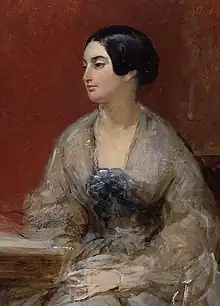Frank Stone (painter)
Frank Stone ARA (22 August 1800 – 18 November 1859) was an English painter. He was born in Manchester, and was entirely self-taught.

Career
He was elected an Associate of the Society of Painters in Water Colours in 1833 and Member in 1843; and an Associate of the Royal Academy in 1851.[1]
The works he first exhibited at the Academy were portraits, but from 1840 onwards he contributed figure pictures, scenes from Shakespeare, scripture and sentimental subjects, many of which were engraved.[2]
In 1850 he led the opposition within the Academy to the innovations of the Pre-Raphaelite Brotherhood, having already criticised their work in the previous year.[3] When Dante Gabriel Rossetti wrote a very critical review of Stone's work in return, Stone launched an outright assault on Pre-Raphaelitism, initiating the controversy that engulfed the movement.[3] Leading Pre-Raphaelite William Holman Hunt later depicted a print of one of Stone's works in the background of his painting The Awakening Conscience. It has been suggested that this was intended as an insult, since the furniture of the room was supposed to represent the bad taste of the characters depicted.[4]

Among London writers and artists Stone had many acquaintances. He was the associate of Thackeray, and of the poets Campbell and Rogers, and the intimate friend of Dickens. From 1845 to 1851 he resided at Tavistock House, Tavistock Square (afterwards the dwelling of Dickens). He frequently assisted Dickens in theatricals, and in 1847 he accompanied the novelist in a troupe of amateur players on a tour in the north.[5]
According to William Powell Frith, Stone was a loyal friend, but very argumentative, "No fair-weather friend was he, but true as steel when friendly countenance might be sorely needed. Still, I confess there were drawbacks to the enjoyment of Stone's society. It was enough for anyone to advance an opinion for Stone to differ from it."[6]
He was the father of the painter Marcus Stone who illustrated many works by Charles Dickens (the Stones were Dickens' neighbours for many years) and himself produced a frontispiece for an edition of Martin Chuzzlewit. He also had a daughter, Ellen Stone.
Stone died on 18 November 1859, and was buried six days later on the western side of Highgate Cemetery.[7] The inscription on his grave (plot no.9947) has largely worn away.
Gallery
 Frank Stone - The Proposal - Victorian Era Painting
Frank Stone - The Proposal - Victorian Era Painting Frank Stone Drawing
Frank Stone Drawing_-_William_Makepeace_Thackeray_-_NPG_4210_-_National_Portrait_Gallery.jpg.webp) William Makepeace Thackeray by Frank Stone (1800–1859)
William Makepeace Thackeray by Frank Stone (1800–1859) Samuel Rogers by Frank Stone
Samuel Rogers by Frank Stone Caroline Norton by Frank Stone
Caroline Norton by Frank Stone Victorian Couple Playing Chess by Frank Stone (engraving) at the British Museum
Victorian Couple Playing Chess by Frank Stone (engraving) at the British Museum.jpg.webp) "Mated" by Frank Stone
"Mated" by Frank Stone
References
- Chisholm 1911, p. 956.
- Chisholm 1911, pp. 956–957.
- Jorge L. Contreras, Frank Stone and the Pre-Raphaelite Brotherhood
- Tate Gallery, The Pre-Raphaelites, 1984.
- Carlyle, Edward Irving (1898). . In Lee, Sidney (ed.). Dictionary of National Biography. Vol. 54. London: Smith, Elder & Co. p. 410.
- Mass, J, The Victorian Art World in Photographs, p. 53
- Cansick, Frederick Teague (1872). The Monumental Inscriptions of Middlesex Vol 2. J Russell Smith. p. 160. Retrieved 9 April 2021.
- This article incorporates text from a publication now in the public domain: Chisholm, Hugh, ed. (1911). "Stone, Frank". Encyclopædia Britannica. Vol. 25 (11th ed.). Cambridge University Press. pp. 956–957.
External links
- 9 artworks by or after Frank Stone at the Art UK site
- Illustrated list of portraits by Frank Stone at the National Portrait Gallery
- Profile on Royal Academy of Arts Collections
- Engraving by John Henry Robinson of a painting 'Donna Julia' with a poetical illustration by Letitia Elizabeth Landon
 The Choice. in Heath’s Book of Beauty, 1833.
The Choice. in Heath’s Book of Beauty, 1833. - Engraving by H. Cook of a painting
 Madeline. with a poetical illustration by Letitia Elizabeth Landon in Heath’s Book of Beauty, 1833.
Madeline. with a poetical illustration by Letitia Elizabeth Landon in Heath’s Book of Beauty, 1833. - Engraving by James Thomson of a painting
 Geraldine. with a poetical illustration by Letitia Elizabeth Landon in Heath’s Book of Beauty, 1833.
Geraldine. with a poetical illustration by Letitia Elizabeth Landon in Heath’s Book of Beauty, 1833. - An engraving by R. H. Dyer of
 The Maid of Lismore. in Finden’s Gallery of the Graces, 1834, with a poetical illustration by Letitia Elizabeth Landon.
The Maid of Lismore. in Finden’s Gallery of the Graces, 1834, with a poetical illustration by Letitia Elizabeth Landon. - An engraving by Charles George Lewis of
 Erinna. in Finden’s Gallery of the Graces, 1834, with a poetical illustration by Letitia Elizabeth Landon.
Erinna. in Finden’s Gallery of the Graces, 1834, with a poetical illustration by Letitia Elizabeth Landon. - Engraving by William Greatbach of a painting
 The Mother’s Warning. in The Amulet, 1836 with a poetical illustration by Letitia Elizabeth Landon.
The Mother’s Warning. in The Amulet, 1836 with a poetical illustration by Letitia Elizabeth Landon. - A poetical illustration by Letitia Elizabeth Landon to the painting
 The Confession. in Forget Me Not, 1836.
The Confession. in Forget Me Not, 1836. - An engraving by C E Wagstaff in Fisher's Drawing Room Scrap Book, 1836 of the painting
 The Lily of the Valley. with a poetical illustration by Letitia Elizabeth Landon.
The Lily of the Valley. with a poetical illustration by Letitia Elizabeth Landon.